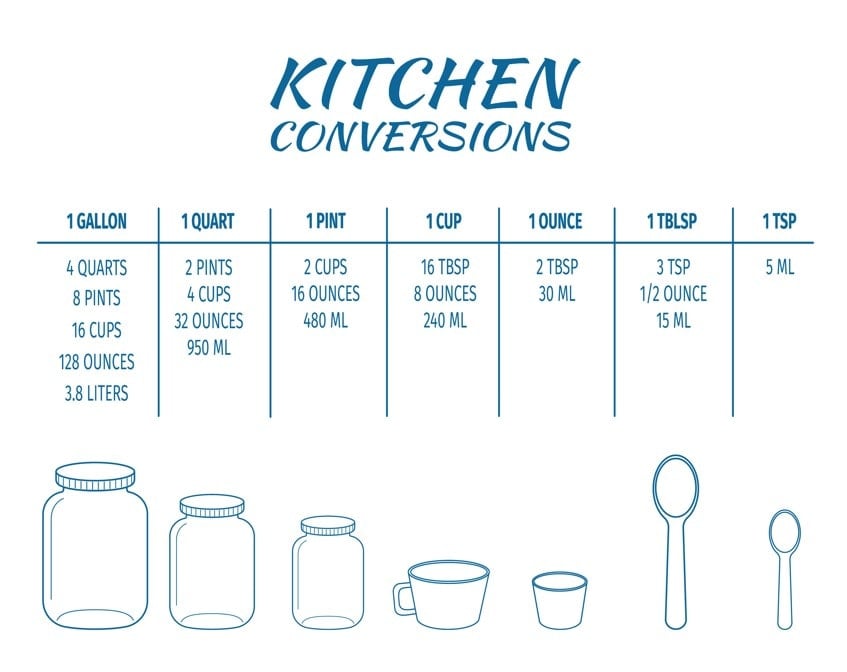This post may contain affiliate sales links. Please read my disclosure policy.

You are probably in the middle of preparing a lip-smacking meal, but your recipe includes pints. And now you aren’t sure how many ounces are in a pint, and how the hell are you supposed to measure those? I’ve got your back!
Here, I will help you understand the conversions and break down how many ounces are in a pint. But first, let’s recap the basics.
Understanding Ounces and Fluid Ounces
An ounce, abbreviated as “oz,” is a unit of weight. A fluid ounce, abbreviated as “fl oz,” is a unit of volume. Ounces commonly measure dry ingredients in baking or cooking, while fluid ounces measure liquid. To differentiate the two units, ounces are for weighing dry ingredients, and fluid ounces are for measuring the space occupied by a substance.
Both in the UK and the US, one ounce is equal to 1/16th of a pound. It means there are 16 ounces in a pound.
There is a slightly different story for fluid ounces. In the UK, one UK fluid ounce equals 1/160th of an imperial gallon, which is equivalent to 28.41 milliliters.
Note that in the US, fluid ounces are measured differently. One US fluid ounce is equal to 1/128th of a US gallon. So, it’s about 29.57 milliliters.
What Is a Pint?
A pint (pt or p) is a unit commonly used to measure volume, but again, there are differences when it comes to the UK and the US. In the UK, a pint is defined as an imperial pint, and it’s commonly used to measure beverages like beer, cider, and milk.
In the US, a pint is also a unit that measures beverages and liquids, but the US pint is smaller than the UK pint. As a matter of fact, the specific measurement of a pint also varies in different countries that use the imperial or US customary systems.
How Many Ounces in a Pint?
I wouldn’t want to confuse you; hence, I will stick to the two measurement systems here: the US liquid pint and imperial pint.
In the UK, an imperial pint equals 20 fluid ounces or about 568.26 milliliters.
In the US, one liquid pint is 16 fluid ounces or 473.18 milliliters.
It’s time to buy tickets to the UK or Ireland and enjoy a larger glass of beer there!
Here is a handy conversion table I’ve prepared for you:
| Fluid ounces | Cups | US liquid pint | Imperial pint |
| 8 fl oz | 1 cup | ½ pints | 0.4 pints |
| 16 fl oz | 2 cups | 1 pint | 0.8 pints |
| 32 fl oz | 3 cups | 2 pints | 1.6 pints |
| 64 fl oz | 8 cups | 4 pints | 3.2 pints |
| 128 fl oz | 16 cups | 8 pints | 6.4 pints |
Wet vs. Dry Pint
I hope my example with beer helped you understand the conversion of fluid ounces to pints because dry pint conversion is a totally different story.
Ordering a pint of beverage, you will end up with a bigger glass in the UK because their measurement system is slightly different. However, purchasing a pint of dry goods will not have the same results.
Essentially, a dry pint measures the volume and not weight because solid food has different densities. So, how many ounces are in a pint in this case?
Here, I want you to think about regular ounces and not fluid ounces. They are used for measuring dry goods like veggies, grains, and berries. For example, a pint of strawberries and a pint of cherries do not weigh the same but take up the same amount of space.
A dry pint is equal to 18.6 ounces in the US, while in the UK, dry produce is measured by weight in grams.
Here is a table to help you convert ounces to dry pints:
| US ounces | Dry pints |
| 1 oz | 0.05 pt |
| 10 oz | 0.53 pt |
| 20 oz | 1.07 pt |
| 30 oz | 1.6 pt |
| 40 oz | 2.14 pt |
| 50 oz | 2.68 pt |
The Bottom Line
The skill of converting ounces to pints may not seem useful at first, but if you are an avid cook or baker, knowing how many ounces in a pint is a must. When in the process of preparing a delicacy, just go to this page and scroll down to the table to help you out. No more wasting time looking for conversions when your cookbook has a recipe with measurements uncommon for your country.
To sum up, in the United States, 1 pint equals:
- 1 fluid pint = 16 fluid ounces
- 1 dry pint = 18.6 ounces
In the UK, 1 pint is equal to 20 fluid imperial ounces or 18.4 US fluid ounces.
When baking or cooking, it’s important to clarify whether the recipe follows the US or imperial measurement system. This way, you will know the exact measurements and end up with a delightful dish.
Frequently Asked Questions
Simply put, the metric system measures weight in grams and volume in milliliters. It was first used in France in the 1700s and later adopted across Europe, including the UK. The UK, to be precise, switched to metric units from the imperial measurement in the 1960s. However, pubs still serve beer in pints, so asking for a glass in millimeters would definitely sound weird over there – it’s a tradition that survived the years.
When it comes to the US, the imperial system was adopted in the 1800s and never really got switched to the European standard.
At the same time, keep in mind that in the UK and Ireland, a pint is 20% bigger than in the US.
Chances are, you are buying blueberries in a plastic or carton container, and blueberries are usually packed to the top of it. As you remember, I mentioned earlier that a pint is equal to 16 US fluid ounces, but with dry ingredients, we can’t really use this metric. What we look at here is a dry pint of blueberries, where a dry pint is a measure of volume. Hence, your pint of blueberries is about 12 ounces or so.
You can expect to see about 10 or 11 ounces in a pint of tomatoes. As a side note, have a look at my delicious fried green tomatoes, where I keep the recipe super easy to understand.
Sour cream is a viscous liquid, but it’s still liquid, so here we should look at the fluid ounces. When measuring sour cream in a measuring cup, I recommend tapping it on the counter to level it up and release air bubbles. In the end, you should end up with 16 US fluid ounces.
Try out cooking sour cream chicken enchiladas, where you can put learned skills to practice and find out the difference between US customary and metric equivalents.




